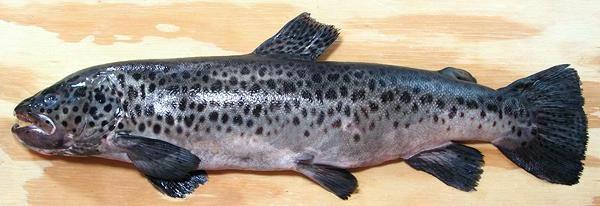 [Ishkhan (Armenia); Salmo ischchan]
[Ishkhan (Armenia); Salmo ischchan]
Four varieties of this relative of the Brown Trout are endemic to
Lake Sevan in Armenia and one has been introduced to Issyk Kul lake in
Kyrgyzstan. The largest variety can grow to almost 36 inches and 33
pounds, but the photo specimen (var Gegharkuni) was 19 inches long
and weighed 2-1/2 pounds.
Winter bakhtak (var ischchan) - the largest, to 35.5 inches, 33 pounds.
Summer bakhtak (var aestivalis)
Gegharkuni (Salmo ischchan gegarkuni) - the photo specimen
Bojak (var danilewskii) - dwarf, to 13 inches, 8.8 oz.
More on Trout Family.
Cooking: Because of its large size, this fish is usually cooked as fillets. Because it's a moderately oily fish, it is suitable for fast high temperature cooking such as frying, broiling or grilling. The flesh is quite sturdy compared to Rainbow Trout, and it holds together very well in poaching. For frying, dust lightly with flour (I use salted rice flour) rather than using batters, and use simple seasonings and sauces that enhance flavor rather than overpower it. Do not skin the fish because much of the flavor is right under the skin.
Buying: The photo specimen was purchased off the ice from a multi-ethnic market in Los Angeles (Altadena) for 2018 US $8.99 / pound. This market is within a couple of miles of Glendale, the Western Capital of Armenia.
Cleaning: In North America all the farmed trout are shipped "factory cleaned", and that's the way this fish was shipped. The gills still needed to be pulled.
Scales: This trout, like other trout, has very small thin scales - so small and thin that only larger fish need to have them scraped off. The specimen fish did not seem to have been scraped, but I was only able to find a very few tiny scales that could be scraped off
Skin: Fillets are easy to skin but the skin is thin and enhances the flavor, so this fish can be cooked and eaten skin-on. Fillets can be fried skin-on because the skin has very little shrink, and then relaxes. Fry the skinless side first to stiffen the fillet, then flip. You'll see some shrink, but just pat it down with your turner and it will relax. I have poached fairly large pieces of fillet, and the skin hardly shrunk at all.
Filleting: The only problem filleting this fish is that there are no bones to follow from the top until you get near the backbone. As you cut down from the top of the fish you will meet resistance just before the backbone. This is a row of numerous pinbones you must cut through or break away from the backbone. I had trouble following the rib cage, so I just cut it from the backbone with kitchen shears and pulled the ribs out with long nose pliers. They pulled very easily.
Once you have the fillet free, set it skin side down and deal with the pin bones. The fillet feels very prickly, but the pin bones are so soft you only need to pull them up near the front of the fillet. The rest disappear in cooking.
Yield: Trout is a high yield fish. The 2-1/2 pound specimen fish yielded 1 pound 9-1/4 ounces (63%). Of course that was from a factory cleaned fish.
Stock: Despite being a modeately oily fish, the heads, fins and bones make a serviceable soup stock, made by our Method. Remove all oil using a gravy separator.
sf_troutsz 181105 - www.clovegarden.com